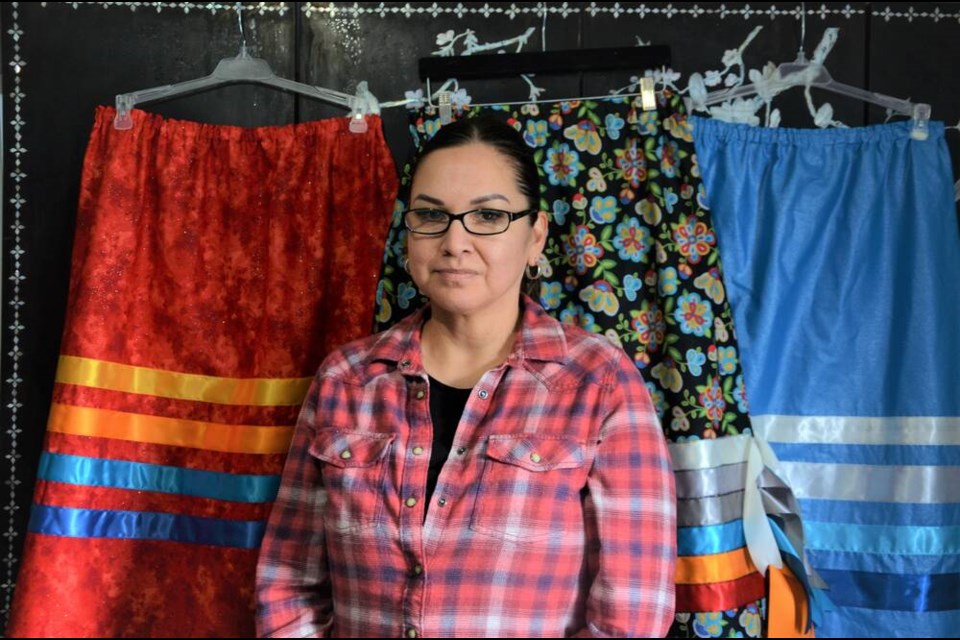When in conversation with Kanani Nahanee, a regalia designer and maker from the Sḵwx̱wú7mesh (Squamish) and Cowichan nations, "honour" is a word that arises often. For the past three decades, Nahanee has been enriching the lives of those around her with her bold and beautiful designs, most recently in the form of vivid ribbon skirts, yet the pleasure, she swears, is all hers.
“Making skirts is like my medicine, with its own therapeutic benefits,” beams Nahanee, from her charming, in-house studio in X̱wemelch'stn (Capilano 5 Reserve).
“When I put on a skirt and beaded earrings, I just feel so beautiful and so uplifted. It’s such a good feeling to be proud of who you are, and be proud of where you come from, and it is an honour to be able to create that feeling for somebody else.”
Nahanee moonlights as a regalia creator when she’s not on the job as a cultural connections worker for the Squamish Nation’s Child & Family Services. She was just 13 years old when she produced her first custom-made piece.
“It was a bright yellow skirt with an appliqué that was just red little hearts,” she reminisces with a smile, describing how the piece, crafted for a six-year-old dancer from her reserve, “kind of snowballed,” into a thriving side hustle. Now, various Indigenous communities across Canada and the U.S. lean on Nahanee’s creative talents, allowing her to bring their visions to life.
“I’ve travelled to very remote communities across the country, travelling by water taxis and seaplanes, driving long dirt roads for two hours, to connect with these people, learn their culture and get to their roots,” she says.
With ribbon skirts being unique to each person, a representation of their own culture, heritage, struggle or life event, Nahanee says each custom-made piece is a collaboration between wearer and designer. It is the wearer who often decides on the colours, distinctive to their own experience or community, and Nahanee pieces together the rest.
She runs workshops for the next generation of skirt makers. Being able to watch the children pick out their own coloured ribbons, and see the pride that the act instills in them, is one facet of her work that will “never get old,” she says. It is here that young seamstresses learn that crafting a piece of regalia is more than just an act of creation, rather it is much like a ceremony in itself.
“It’s not just sitting down and cutting and sewing,” she says.
“What I was taught from my elders, which was handed down by our ancestors, is that when you’re working on something like this, your energy is going into that and you have to have the right mindset, the right energy, good energy, good thoughts and prayer.” What energy is channelled into that regalia or ribbon skirt will affect the wearer, and so no piece should be crafted while in an unfavourable mindset, she says.
Now, when she sits in her sun-dappled sewing spot surrounded by shelves packed with vibrant materials and rows upon rows of multi-hued ribbons, Nahanee focuses on how grateful she is to be able to showcase her creations to the world. She acknowledges the steps forward that are being made – like Ribbon Skirt Day, which was formally acknowledged for the first time earlier this month as an annual day to recognize, learn about, and celebrate the importance of Indigenous traditions and expressions of culture – and remembers those who came before who weren’t allowed such freedoms.
“This is my way of honouring our history, my elders’ history and my ancestors’ history, those who were not allowed to do this. It’s a way of honouring what they went through, their struggles, their deprivations,” she said.
Mina Kerr-Lazenby is the North Shore News’ Indigenous and civic affairs reporter. This reporting beat is made possible by the Local Journalism Initiative.



